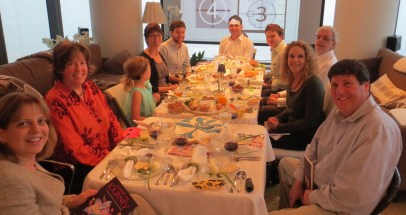Last year I was in Jerusalem for the High Holy Days. The experience of being in Israel for this focal point of the Jewish year, especially as it coincided with my entering into Rabbinical school at HUC-JIR, provided a new layer of meaning to the holidays for me. Praying with my community while looking out into the Old City through the gorgeous windows of Blaustein Hall in Beit Shmuel, I was drawn to connect to the past of our people. For millennia, the hill that I was gazing upon has been the central focus of this very service. Our ancient predecessors worshiped the same God, at the same time of year, by making animal sacrifices on the hill framed right in front of the entire HUC-JIR Jerusalem community, where our eyes rested as we prayed through our traditional liturgy.
The High Holy Days are often described as an ominous period that evokes reflection on mortality and the worth of our lives. As Rabbi Ismar Schorsch wrote, quoted in the Rosh Hashanah Morning portion of Mishkan haNefesh, “we gather again in the fall against the backdrop of a natural world that is beginning to wither in order to contemplate what the passage of time means in our own lives.”
I have never felt this theme of the High Holy Days as acutely as I do now. In stark contrast to last year, in which our services were planned out and led by the faculty of HUC-JIR, this year the responsibility is all mine. In the coming weeks I will, for the first time, be leading a community in their High Holy Day worship. No musical accompanist, no senior authority to follow – just myself. This is a humbling prospect, and one that certainly makes me contemplate the path that led me here.
The majesty and power of the High Holy Days has often been lost on me. As a child, I looked forward to Yom Kippur only for the annual break-fast we held at my house with our community of friends. Dramatic, operatic choirs and music, prayers speaking to a king-like God of which I saw no proof in my life, and sweating in an overcrowded sanctuary, did not draw me into the spirit of teshuvah, nor did it make me feel connected to the tradition being put forth. Instead, I felt alienated and, for many years, stopped attending High Holy Day services altogether.
Now, it is my turn to be the one leading a community of people who may or may not feel completely alienated by the service they are going to attend. More likely than not, most of the people in attendance at the small Hillel where I will be leading are going to be searching for a sense of home, a sense of community, and a sense of meaning. They will want the familiar, but will also want to be engaged in something that intelligently challenges their worldview. They will be searching, as I have in the past, for something that connects them our tradition in the way they have heard others speak about the transformative power of the rituals and liturgy. When I consider the fact that it is my responsibility to bring this about, the opening to Hin’ni speaks to me more than it ever has before: “Here I am. So poor in deeds, I tremble in fear, overwhelmed and apprehensive before You to whom Israel sings praise.”
Many of my classmates are in a similar position. Some are going to other Hillels, some are going to small communities throughout our country from Wyoming to Arkansas, all with the same new experience of the High Holy Days awaiting them as fall arrives. Each location has its own set of circumstances around the days, but the main theme is the same: We are no longer congregants in the pews, we are now leaders on the pulpits.
 I feel incredibly lucky that, in spite of my apprehension and fear, I have the opportunity to make use of the new Reform machzor, Mishkan haNefesh, as my guide for leading this community. Although I grew up using Gates of Repentance, I still associate it with the alienation and frustration of my earlier years. It is a wonderful coincidence that for my fresh start with the High Holy Days I am gifted the experience of using a new form of our tradition as the foundation for my leadership. We are in this together, and both of us are pretty new to the task. I hope that Mishkan haNefesh and I will be able to provide the students of Gettysburg College Hillel meaningful holiday worship that invites rather than alienates, that inspires rather than bores. I look for to writing further about this experience after the gates have closed, and we are on solid footing in 5775. Shanah Tovah!
I feel incredibly lucky that, in spite of my apprehension and fear, I have the opportunity to make use of the new Reform machzor, Mishkan haNefesh, as my guide for leading this community. Although I grew up using Gates of Repentance, I still associate it with the alienation and frustration of my earlier years. It is a wonderful coincidence that for my fresh start with the High Holy Days I am gifted the experience of using a new form of our tradition as the foundation for my leadership. We are in this together, and both of us are pretty new to the task. I hope that Mishkan haNefesh and I will be able to provide the students of Gettysburg College Hillel meaningful holiday worship that invites rather than alienates, that inspires rather than bores. I look for to writing further about this experience after the gates have closed, and we are on solid footing in 5775. Shanah Tovah!
Andy Kahn is a second year Rabbinical student at HUC-JIR in New York, and is also a Rabbinic Intern at CCAR Press.
























